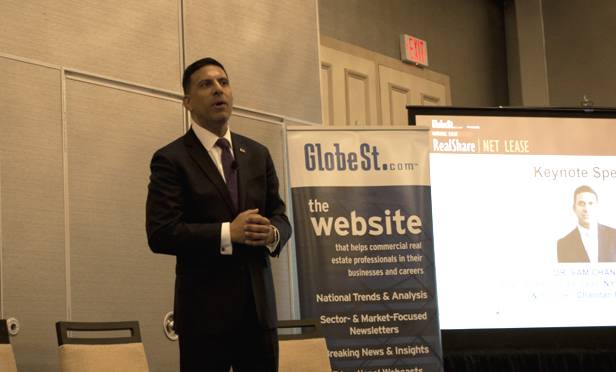
NEW YORK CITY—The keynote speaker at the 2018 RealShare Net Lease Conference in New York City, Sam Chandan, the chair and associate dean at NYU Schack Institute, said most people don't read economic data. Their sense of the economy is based on their job security, career promotions, salary increases and what happens to friends and family members who lose their jobs.
For many Americans it does not feel like the recovery began in 2008. While the economy was growing for what's approaching 10 years, in the labor market many people have not experienced the benefit of the economy's strength. This was due to the role technology has played in driving economic expansion in the US, according to Chandan.
He explained that 40 years ago to increase production, the economy needed capital and labor. Companies could not drive up production and grow without added labor—meaning hiring more people. But as production continues to advance its technology orientation, companies can produce more and create added value without more people.
“We can experience growth in the US economy without hiring more people,” said Chandan. For the first time in 2001 during and after the recession with the dot-com boom and bust, the economy experienced a “jobless recovery.” Chandan pointed out it was the first time that there was growth in the US economy, better outcomes in the stock market but without people consistently getting jobs.
This is critical for the real estate industry because without bringing people back into the workforce there is no driver for the demand of commercial real estate. The economy needs to create jobs and pay income for the real estate industry to be supported and to flourish.
The Minksy model states that extended periods of market speculation or unsustainable growth inevitably leads to an economic crisis. Economic expansions and contractions can be measured by society's willingness to take risks. However, Chandan asserted that the greater tolerance for risk, willingness to get away from core investments created the net lease industry and fueled the economy.
“If we are not willing to take risks, not willing to invest high dollar prices relative to the income the property is producing, not willing to go to secondary, tertiary markets, we are simply not going to be players in this game,” said Chandan. He pointed to the cap rates and the valuation assets command as consistent with having greater toleration for risk than in the past.
Although Chandan doubts that commercial real estate will drive the next inflection point in the economy, it's an important piece.
There is a vast amount of debt in the commercial real state industry and concern about changes in valuations as cap rates begin to rise. There have also been concerns regarding the multifamily sector.
“There's a lot more debt out there than there ever has been before in the multifamily sector and that doesn't get nearly as much attention as the growth in the inventory,” said Chandan. “For every apartment out there we have more debt out there than ever before. Our ability to service that debt in an environment where it's more difficult for us to refinance at high leverage and low cap rates, the debt that we've taken on when that money was as close to free as we've ever seen, that's going to be a challenge.”
Those risks are back-ended around the ability to refinance in an environment with a set of economic conditions that at this point are unknown. Chandan says interest rates will rise and there will be a period of economic weakness, although no one knows exactly when that will occur.
© Touchpoint Markets, All Rights Reserved. Request academic re-use from www.copyright.com. All other uses, submit a request to [email protected]. For more inforrmation visit Asset & Logo Licensing.







